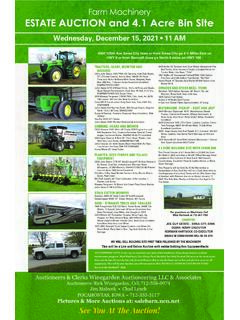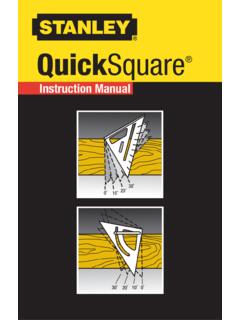Transcription of Architectural Patterns
1 A PATTERN BOOK FOR NEIGHBORLY HOUSES Architectural PATTERNSDA series of well-developed Architectural styles or vocabu-laries were popular throughout the United States in the19th and early 20th century. These styles were adapted bylocal builders through the use of early pattern books andlater catalogs of house plans. Many early houses were builtwithout the aid of pattern books and are increasingly styles represent the broader Patterns found in theneighborhoods constructed largely before 1940. Eachstyle has become adapted to the local environment andlocal building principal architecturalstyles can be found throughoutthe United States, which whenadapted to local requirements,give neighborhoods uniquecharacter.
2 These styles aredescribed in more detail withtypical key elements in the following pages. Classical and Colonial Revival Victorian Arts & Crafts MissionHouses that adhere to the traditionalarchitectural and neighborhood pat-terns add to the quality of the publicrealm and encourage the safety andvitality of a PatternsINSTITUTE OF CLASSICAL ARCHITECTURE AND CLASSICAL AMERICA29 VictorianArts & Crafts Overview of American Architectural StylesClassical and Colonial RevivalMission 30 Classical and Colonial RevivalA PATTERN BOOK FOR NEIGHBORLY HOUSES Architectural PATTERNSDC olonial Revival houses reflect the renewed national interest inClassicism which occurred in the late 19th century. The architecture cre-ated for the 1893 World s Columbian Exposition in Chicago is a famousexample of this revival.
3 Significant examples of houses from this periodcan be found throughout the United the first half of the 20th century, the Colonial Revival style emergedin the United States as a recognized American-born Architectural Revival style houses were derived from Anglo east coast colonialprecedents, which also incorporated eclectic interpretations of classicaldetails on simple massing Revival style houses have a simple dominant main body(which can be one or two stories) to which side wings, rear wings,and pavilions might be added. The following illustrations include bothhistoric examples and recently built houses to show the continued use ofthis building tradition. Simple, straightforward volumes with sidewings and porches added to make morecomplex shapes An orderly, symmetrical relationship ofwindows, doors, and building mass Simplified versions of classical details andcolumns, occasionally with classical ordersused at the entry Large windows with six-pane Patterns ,sometimes pairedESSENTIALELEMENTS31 Step 1:Massing, Composition, and MaterialsSide GableFront Gable L ShapeA.
4 Choose Massing Type Massing typologies are generally very simple with side wings if necessary Both gable and hip roofs are common Roof pitches typically range from 6:12 to 10 Window andDoor Composition Window Patterns are generally repetitive and very simple with equal space between windows and doors. Compositions are often symmetrical with an odd number of bays. Accent windows and grouped standard windows can be used for emphasis. Wider houses typically have the entrance in the center of the facade whereas narrower houses generally have doors on the MaterialsSiding: Cementitious siding or vinyl Exposure: 5-8" Corner boards: 4-6"Colors: Body: Generally, all siding is the same color Trim: White or off-white28' 38'1/51/51/51/51/518' 32'1/31/31/322' 30'1/21/218' 32'1/31/31/322' 36'1/31/31/318' 28'2/31/332A PATTERN BOOK FOR NEIGHBORLY HOUSES Architectural PATTERNSA.
5 Select Eave Detail Overhangs typically range from 9" to 18" in depth. Many different designs can be created by variations in roof pitch,gable end treatment, mouldings,and dimensions. Boxed-eave detail works for both hip and gable roofs. Typically the same detail throughout the countryTypical Eave SectionGable End Porch Location and Design Porches can range from single-bay porticoes to five-bay full facade porches. Single-bay porches typically have a gable roof and pediment. Larger porches generally have hip or shed roofs. Columns are typically 8 or 9 feet tall; simple, straight box columns,or architecturally correct, doric columns are most common;narrower columns can be paired. Porch eave detail resembles that of the house; column neck and beam should be the same width and of Typical PorchSquare ColumnGable End SectionSide GableFront Gable L ShapeDoric Column8"8" 14"9" 18"6 10125" Ogee GutterCrown Moulding2 512 Flashing8"6" 10"Blocking2"x 4" LookoutFriezeOptional ReturnCorner BoardRake BoardFlashingGutter8"10" 18"6" 14"3-4125" Ogee GutterCrown Mouldingequal2"x 2" PicketsBrick Facing8'-0" to 9'-0"8'-0" to 9'-0"2"x 2" Cap2" QuarterRound1" Half Round1"x 10"ChamferedBase1"x 8" or 1"x 10"Box Around Structural Post10" 14"8" 12"Step 2:Eaves and Porches33B.
6 Select Doors Wood, fiberglass, or steel with traditional stile and rail proportions,panel profiles, and glazing Patterns Six- and eight-panel doors are common; partially glazed and fully glazed doors are also used. Door trim should match window Select Windows Double hung windows with 6 over 1 or 6 over 6 mullion Patterns are typical. Standard window dimensions:Width: 2'-4" to 3'-4"Height: 5'-0" to 6'-5" Standard windows are often paired with a 6" mullion (trim) division. Accent windows should have panes of similar proportion to the standard windows used. Accent windows are typically used only when space is limited ( , overcounters, bathroom fixtures, etc.) oras compositional 6-over-1 Double-Hung WindowPaired Double-Hung WindowAccent WindowPartially Glazed DoorFully Glazed DoorPanel DoorStandard 6-over-6 Double-Hung WindowC.
7 Select Trim and Shutters Windows and doors have simple 4 to 6 inch trim. Caps, backband mouldings, and aprons under the sill are common. Shutters are typically paneled or louvered and should be half the width of the " 6"6"6" 8"Simple 6-inch Trim Backband TrimPaneled and Louvered Shutters5/4"x 6"Cap2"x 3" SillBackbandMouldingApronStep 3:Windows and Doors34 VictorianA PATTERN BOOK FOR NEIGHBORLY HOUSES Architectural PATTERNSDThe Victorian era refers to the years during which Queen Victoria ruledEngland, but in reference to American architecture it defines the nation-al style that achieved widespread popularity toward the end of her reign,specifically in the years between 1860-1900. These years saw the rise ofthe railroad and growth of industrialization, which led to big changes inthe construction of American homes.
8 Traditional heavy timber framingmethods were being replaced, and consequently Architectural styles beganto evolve. The emergence of factories accelerated the production of doors,windows, and detailing. Ornate details had once only been available forlandmark houses, but with the combination of mass production and low-cost transportation along railways, complex shapes and elaborate detailsbecame affordable options for all homes. The style was also readily acces-sible to many home builders as a result of pattern books that provideddrawings of these early house houses in the Victorian style were often complex in form,creating picturesque compositions. Heavily detailed porches, elaboratewoodwork, and textures created by scalloped, diamond, and fish-scaleshingles were all common features.
9 While exotic Victorian houses incor-porating Eastlake, Queen Anne, and Italianate details grew in populari-ty throughout the country, a more restrained style known as folk-basedVictorian also emerged, which adapted the elegant styles of Victorianarchitecture to smaller, simple houses. Prominent porch elements added to simplymassed houses to create more complex forms An orderly, symmetrical relationship betweenwindows, doors, and building mass Cut wood ornament influenced by naturalforms or turned decorative millwork Vertically proportioned windows and doorsESSENTIALELEMENTS35 Step 1: Massing, Composition, and MaterialsSide GableFront Gable L ShapeA. Choose Massing Type Hipped or side-gabled rectangu-lar volume, often with a dormer flush to the front facade Roof pitch is typically 8:10 One-story shed or hip front porches from one-fifth to the full length of the main body Window andDoor Composition Characterized by a symmetrical and balanced placement of doors and windows Same window design throughout,with the exception of special windows Often, the first-floor windows arelarger than the second floor.
10 Align door head with window heads. Symmetrical and balanced place-ment of doors and windows Entrance doors are located in the corner of narrow houses and the center of wide Materials Siding: Wood or fiber cement board Exposure: 5-8" Corner boards: 3-7"Colors: Body: Pastels and a range of yellows, beiges, grays, blues,and greens Trim: Deeper shade of the body color or a slightly different deep shade; white trim may be used28' 36'1/51/51/51/51/518' 24'1/31/31/326' 34'2/51/518' 34'1/31/31/318' 32'1/31/31/318' 26'2/31/31/51/536 Side GableFront Gable L ShapeA PATTERN BOOK FOR NEIGHBORLY HOUSES Architectural PATTERNSStep 2:Eaves and PorchesA. Select Eave Detail Overhang between 8 inches and 16 inches; deeper overhangs are typically used on larger houses Boxed eaves often have profiled brackets at 8 to 24 inches on center and grouped at corners.





